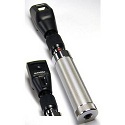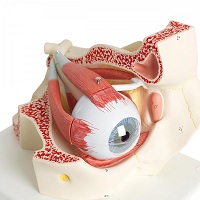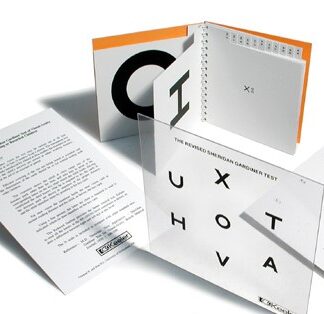Description
Cardiff Contrast Test is designed for low contrast measurement in toddlers and young children, and in older children or adults with intellectual impairment.
THE VALUE OF LOW CONTRAST
Low Contrast is the ability of the visual system to detect large but faint targets. There are some pathological conditions that reduce contrast sensitivity without impairing visual acuity, and the test will help in the identification of these conditions. However, reduced contrast sensitivity and reduced visual acuity often occur together, so that some (by no means all) children with visual impairment also have reduced contrast sensitivity. Tests for the two functions are therefore complementary and obtaining a measure of both will give a fuller description of visual deficits than will one alone.
A child with visual impairment who retains good contrast sensitivity will benefit from enlargement of tasks. He or she sees large faint objects well. A child with an equivalent acuity but with reduced contrast sensitivity has a much more severe impairment, and will not get the same benefit from enlargement. Large objects as well as small objects are difficult to see. So a measurement of contrast sensitivity can help determine appropriate management of a child’s impairment.
Treatment for visual deficits (including amblyopia therapies) can result in improved contrast sensitivity sometimes in the absence of increased visual acuity. Contrast sensitivity can therefore be an essential tool in monitoring therapies. Some progressive eye conditions will result in changes in contrast sensitivity, so that monitoring contrast sensitivity alongside visual acuity (and other visual functions) may be essential in determining progress of the condition.
THE TARGETS
Like its ‘sister’ test, the Cardiff Acuity Test, the Cardiff Contrast Test uses vanishing Optotypes. The targets are drawn with a light band bordered by two darker bands, each of half the width of the light band, all on a neutral gray background; thus the average luminance of the target is equal to that of the gray background. If the target lies beyond the subject’s contrast limit, it merges with the gray background, and simply becomes invisible.
The targets employed by the test are pictures, all of the same overall size, but decreasing in contrast between the light and dark bands. The contrast sensitivity is determined by the faintest bands for which the target is visible. The test covers 12 Contrast levels using three Cards at each level (36 cards total) using the preferential looking technique. These contrast levels start at 46% and decrease to 1 % which equates to sensitivity leves from 2.17 to 100.
When the Cardiff Contrast Test is carried out at a distance of 50 cm the targets represent 1.9 cycles per degree (or 6/90, 20/300) and at a distance of 1 m the targets represent 3.8 cycles per degree (or 6/45, 20/150). At a distance of 25 cm the targets represent 1.0 cycle per degree (or 6/180, 20/600).
Results from the test are presented in a manner that is consistent with scoring of the Pelli-Robson Contrast Test for adults. The test has recently been adapted slightly to make the subject pictured in the drawings more appropriate for use with both children and adults with intellectual impairment. Fun Frame occluding glasses are included with each Cardiff Test Contrast Sensitivity set and the set now has cards laminated on both sides.



























